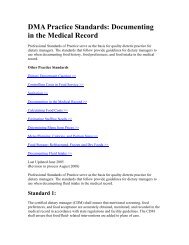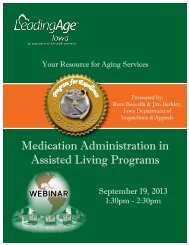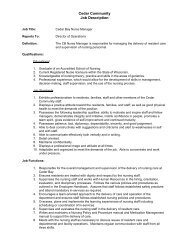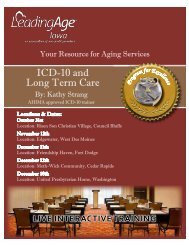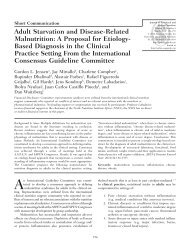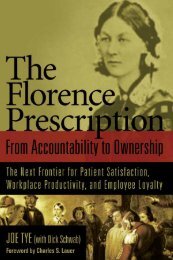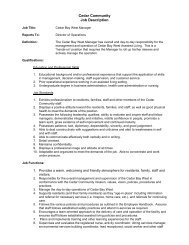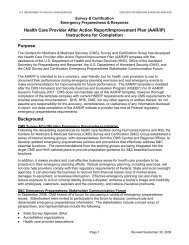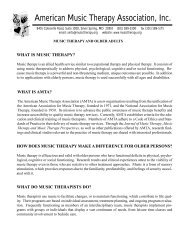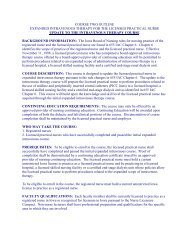Level IILevel IIILevel IVLevel VTwo groups, nonrandomized studies (e.g., cohort, case-control)One group, nonrandomized (e.g., before and after, pretest and posttest)Descriptive studies that include analysis <strong>of</strong> outcomes (e.g., single-subject design, case series)Case reports and expert opinion that include narrative literature reviews and consensus statementsNote: From "Evidence-based medicine: What it is and what it isn't," by D. L. Sackett, W. M. Rosenberg, J. A. Muir Gray, R. B. Haynes, & W.S. Richardson, 1996, British Medical Journal, 312, 71–72.Methods Used to Analyze the EvidenceReview <strong>of</strong> Published Meta-AnalysesSystematic Review with Evidence TablesDescription <strong>of</strong> the Methods Used to Analyze the EvidenceThe two teams working on each focused question reviewed the articles according to their quality (scientific rigor andlack <strong>of</strong> bias) and levels <strong>of</strong> evidence. Each article included in the review was then abstracted using an evidence tablethat provides a summary <strong>of</strong> the methods and findings <strong>of</strong> the article, an appraisal <strong>of</strong> the strengths and weaknesses <strong>of</strong>the study on the basis <strong>of</strong> the design, methodology, and implications for occupational therapy. Review authors alsocompleted a Critically Appraised Topic (CAT), a summary and appraisal <strong>of</strong> the key findings, clinical bottom line, andimplications for occupational therapy <strong>of</strong> the articles included in the review for each question. Review authors alsocompleted Critically Appraised Papers for all articles included in the perception and routines reviews and the Level I, II,and III articles for the occupation review. American <strong>Occupational</strong> <strong>Therapy</strong> <strong>Association</strong> (AOTA) staff and the Evidence-Based Practice Project consultant reviewed the evidence tables and CATs to ensure quality control.Limitations <strong>of</strong> selected studies incorporated in the review include small sample size, lack <strong>of</strong> power analysis, and limiteddetail regarding recruitment <strong>of</strong> participants. In several cases, the study group was heterogeneous and may not havebeen representative <strong>of</strong> the population with dementia. Depending on the level <strong>of</strong> evidence, there may have been a lack<strong>of</strong> randomization, lack <strong>of</strong> control group, and limited statistical reporting. In many cases, the studies included both alimited description <strong>of</strong> the outcome measure and explanation <strong>of</strong> the psychometric properties <strong>of</strong> the measures. In somecases, the outcome measures were subjective, and there was limited follow-up <strong>of</strong> the intervention. It is difficult toseparate the effects <strong>of</strong> a single intervention that is part <strong>of</strong> a multimodal intervention. In addition, adverse effects <strong>of</strong> anintervention may not have been included, and some studies did not control for confounders in the analysis. Several <strong>of</strong>the qualitative studies were limited by the amount <strong>of</strong> information provided about the data collection and analyticprocedures. Because several were published before 2001, the review author indicated that this may be a reflection <strong>of</strong>fewer demands related to trustworthiness and credibility as part <strong>of</strong> a general limited understanding <strong>of</strong> qualitativeresearch in older literature.Methods Used to Formulate the RecommendationsExpert ConsensusDescription <strong>of</strong> Methods Used to Formulate the RecommendationsNot statedRating Scheme for the Strength <strong>of</strong> the RecommendationsStrength <strong>of</strong> RecommendationsA—Strongly recommend that occupational therapy practitioners routinely provide the intervention to eligible clients.Good evidence was found that the intervention improves important outcomes and concludes that benefits substantiallyoutweigh harm.B—Recommend that occupational therapy practitioners routinely provide the intervention to eligible clients. At leastfair evidence was found that the intervention improves important outcomes and concludes that benefits outweigh harm.C—No recommendation is made for or against routine provision <strong>of</strong> the intervention by occupational therapypractitioners. At least fair evidence was found that the intervention can improve outcomes but concludes that thebalance <strong>of</strong> the benefits and harm is too close to justify a general recommendation.D—Recommend that occupational therapy practitioners do not provide the intervention to eligible clients. At least fairevidence was found that the intervention is ineffective or that harm outweighs benefits.I—Insufficient evidence to recommend for or against routinely providing the intervention. Evidence that theintervention is effective is lacking, <strong>of</strong> poor quality, or conflicting and the balance <strong>of</strong> benefits and harm cannot bedetermined.Note: Recommendation criteria are based on standard language developed by the Agency for Healthcare Research and Quality (2009).Cost AnalysisThe guideline developers reviewed published cost analyses.Method <strong>of</strong> Guideline ValidationPeer ReviewDescription <strong>of</strong> Method <strong>of</strong> Guideline ValidationContent experts reviewed this guideline.RecommendationsMajor RecommendationsReferralIn the early stages <strong>of</strong> Alzheimer's disease, referral to occupational therapy is appropriate when an individual exhibits adecline or impairment in performance <strong>of</strong> functional activities because <strong>of</strong> problems with thinking, memory, or executivefunction. The individual may report general memory or communication difficulties to a health care provider, but <strong>of</strong>ten afamily member is the one who raises concerns about occupational performance in instrumental activities <strong>of</strong> daily living(IADLs) and hazardous activities such as cooking on a stovetop, operating machinery, or getting lost when driving.These concerns are frequently echoed by adult children, employers, friends, and community members. In the early
RecommendationsMajor RecommendationsReferralIn the early stages <strong>of</strong> Alzheimer's disease, referral to occupational therapy is appropriate when an individual exhibits adecline or impairment in performance <strong>of</strong> functional activities because <strong>of</strong> problems with thinking, memory, or executivefunction. The individual may report general memory or communication difficulties to a health care provider, but <strong>of</strong>ten afamily member is the one who raises concerns about occupational performance in instrumental activities <strong>of</strong> daily living(IADLs) and hazardous activities such as cooking on a stovetop, operating machinery, or getting lost when driving.These concerns are frequently echoed by adult children, employers, friends, and community members. In the earlystages <strong>of</strong> the disease, a referral is indicated if cognitive limitations are barriers to participation in daily living skills,social activities, leisure interests, or work and volunteer activities. In the middle stages <strong>of</strong> the disease, additionalindications for referrals may be to determine service needs such as home health assistance, memory care or dayservice programs, or caregiver respite support. In later stages <strong>of</strong> the disease, occupational therapy is referred toresolve barriers to performance in self-care or to manage challenging behaviors such as agitation, aggression,disruptive vocalizations, wandering, altered sleep–wake cycles, catastrophic reactions, or frustrations related tocommunication problems.Referrals may be initiated by a client or a family member or may come from a physician (geriatrician, geropsychiatrist,neurologist, family practitioner), nurse (nurse practitioner, public health nurse), neuropsychologist, or social worker.The referral may indicate a specific purpose for the occupational therapy evaluation, such as cognitive performancetesting for diagnostic information (for the physician, the presence <strong>of</strong> cognitive deficits that affect functionalperformance may discriminate mild cognitive impairment from dementia; a physician would use this information indiagnosing) or be a general order for an evaluation and intervention. For some clients, their first encounter withoccupational therapy is in rehabilitation in a transitional or subacute care unit after a precipitating event, such as a fallor illness. A cognitive functional screening as part <strong>of</strong> an occupational therapy evaluation may serve as a referral forfurther cognitive assessment. Some specialty memory disorder clinics that use a team approach have a standingreferral for clients that includes occupational therapy evaluation as an integral part <strong>of</strong> a comprehensive assessment fordementia.EvaluationThe occupational therapy evaluation is conducted with the client, caregiver or family member, or health care proxy t<strong>of</strong>acilitate an accurate exchange <strong>of</strong> information. Questions should be directed toward the client, allowing the client totake an active and central role in the interview process. Others present should be encouraged to provide additionalinformation, if appropriate. Information is gathered through an occupational pr<strong>of</strong>ile (interview), analysis <strong>of</strong> occupationalperformance (observation), and standardized and nonstandardized assessments. This section <strong>of</strong> the Guideline outlinesareas for evaluation using the <strong>Occupational</strong> <strong>Therapy</strong> Practice Framework (see "Availability <strong>of</strong> Companion Documents"field) classification and justifies the rationale as it relates to characteristics <strong>of</strong> Alzheimer's disease.The occupational therapist obtains client information through the occupational pr<strong>of</strong>ile to determine barriers tooccupational performance. If cognition is the primary concern limiting participation, a brief cognitive assessment usinga screening tool such as the Large Allen Cognitive Lacing Screen is administered to determine whether a full cognitivefunctional assessment is warranted. Some standardized cognitive functional assessments such as the CognitivePerformance Test (CPT) or the Executive Function Test may require additional training to administer and interpret,reflecting a specialized area <strong>of</strong> practice.An individual with cognitive deficits may exhibit a decline or impairment in performance <strong>of</strong> functional activities causedby comorbidities that affect motor and praxis, sensory-perceptual, emotional regulation, cognitive, communication, andsocial skills. One difficulty in assessment with comorbidities is delineating the source <strong>of</strong> the performance deficit. Withclinical expertise, all factors that limit occupational performance are considered, along with thinking, memory, orexecutive function abilities. These factors need to be considered when selecting valid assessment tools. For instance,verbally based assessments may not be valid when auditory deficits are present, and perceptual tests lose validitywhen visual deficits are evident. Through skilled selection and administration <strong>of</strong> the assessment and interpretation <strong>of</strong>the results, the occupational therapy evaluation contributes to an individualized intervention plan.<strong>Occupational</strong> Pr<strong>of</strong>ile (Family/Caregiver Pr<strong>of</strong>ile)The occupational pr<strong>of</strong>ile is a nonstandardized assessment to obtain background information about the client (see Table3 in the original guideline document). It includes demographic information about the client, family members, livingsituation, employment or employment history, education, caregivers or people responsible for care, diagnoses includingmental health diagnoses, resources, and reasons for the referral. Questions about leisure interests, strengths andlimitations to participation in daily activities, and goals <strong>of</strong> intervention can be included (see Table 4 in the originalguideline document for sample questions). The Canadian <strong>Occupational</strong> Performance Measure is an evidence-based,standardized tool used to identify occupational performance issues and to prioritize the selection <strong>of</strong> intervention goalswith client and family input. Client and family goals are obtained to guide the family-centered intervention process.The occupational pr<strong>of</strong>ile includes the client and family member's description <strong>of</strong> the cognitive or memory impairmentsthat may affect safety. Through the interview, the occupational therapist gains a sense <strong>of</strong> the client's self-awareness<strong>of</strong> disability. Self-awareness is important in making recommendations about supportive living situations and levels <strong>of</strong>assistance needed to remain safe in the home environment. Family members should be asked to describe theirobservation <strong>of</strong> the client's memory or thinking problems. The client's perception may differ from the family member'sperception, especially in the middle to later stages <strong>of</strong> the disease, which will influence the strategies for intervention.Observation <strong>of</strong> the client provides an opportunity to screen for client factors that may guide the appropriate selection<strong>of</strong> assessments.An occupational history provides information regarding participation in daily activities. "Describe a typical day" is astandard question. The client will identify activities he or she is able to perform or enjoys doing and may be consideredthe client strengths. Often these activities are habits or routines that are well rehearsed or rote, drawn from long-termor procedural memory. An occupational history includes information about those activities the client used to do but nowfinds challenging. An "interest checklist" can stimulate discussion about activities the client desires to continue andbarriers to participation. Attention to the amount <strong>of</strong> time the person is engaged in activities is important because <strong>of</strong>the tendency to socially isolate or sleep for lengthy periods during the day or the propensity for occupationaldeprivation (obstructing occupational enjoyment because <strong>of</strong> disease) in the middle to later stages <strong>of</strong> the disease.An important part <strong>of</strong> the occupational pr<strong>of</strong>ile is to gain information about the physical environment, or living situation,and social environment, or available caregiver support. Key to effective management <strong>of</strong> the disease is providingenvironmental supports for safety and optimal functioning. Clients with dementia symptoms come to an evaluationfrom a variety <strong>of</strong> living situations with different levels <strong>of</strong> support—from living independently in a single family home toresiding in a memory care facility with 24-hour supports in place. Promotion <strong>of</strong> security is targeted to prevent the sixmost common household injuries: falls and slips, burns, poisoning, cuts, electrocution, and drowning. A home safetyassessment such as the Home Environmental Assessment Protocol or Safety Assessment <strong>of</strong> Function and theEnvironment for Rehabilitation can highlight necessary adaptations to the home to promote a safe environment andsupport caregiver supervisory responsibilities.A significant factor in managing care throughout the course <strong>of</strong> the disease is the presence <strong>of</strong> a caregiver. A study on



